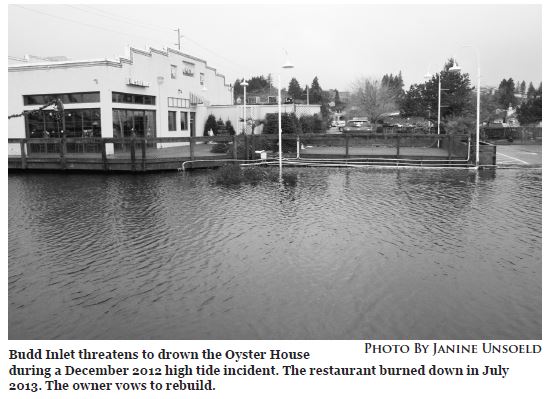Valuing Our ShorelineBy Harry Branch
The prevailing belief seems to be that we get more bang for our buck by preserving less damaged places than trying to fix damaged places. Since there's only so much money in the pot we should invest it where we get the most bang for our buck, that is, elsewhere. And since the shoreline of Budd Inlet is fill, restoration would entail removing downtown Olympia from the map, which isn't going to happen. In reality, restoring ecological function doesn't mean restoring everything under the sun to pre-development conditions. And the fact that Budd Inlet is degraded doesn't mean it doesn't matter under the law. According to the Process to Prepare or Amend Shoreline Master Programs, WAC 173-26-201(2)(a): "Nearly all shoreline areas, even substantially developed or degraded areas, retain important ecological functions. For example, an intensely developed harbor area may also serve as a fish migration corridor and feeding area critical to species survival. Also, ecosystems are interconnected. For example, the life cycle of anadromous fish depends upon the viability of freshwater, marine, and terrestrial shoreline ecosystems, and many wildlife species associated with the shoreline depend on the health of both terrestrial and aquatic environments. Therefore, the policies for protecting and restoring ecological functions generally apply to all shoreline areas, not just those that remain relatively unaltered." In studying marine ecosystems, the relevant disciplines should be ecology and oceanography. How do alterations in physical parameters impact chemical and biological parameters? If we're considering future modifications to physical structure, we need to know how past alterations to physical structure have impacted chemical and biological parameters. Maybe the science will be inconclusive, but we can't simply pretend science doesn't exist. WAC 173-26-201(2)(a), states that a city should: "First, identify and assemble the most current, accurate, and complete scientific and technical information available that isapplicable to the issues of concern. The context, scope, magnitude, significance, and potential limitations of the scientific information should be considered. At a minimum, make use of and, where applicable, incorporate all available scientific information, aerial photography, inventory data, technical assistance materials, manuals and services from reliable sources of science." The City seems to believe that there can be no reclassification of land uses or other effort to improve ecological function if such effort might be viewed as a restriction or change of land use. Actually, in a degraded water body, this isn't exactly the case: "Master programs shall also include policies that promote restoration of ecological functions, as provided in WAC 173-26-201 (2)(f), where such functions are found to have been impaired based on analysis described in WAC 173-26-201 (3)(d)(i). It is intended that local government, through the master program, along with other regulatory and non-regulatory programs, contribute to restoration by planning for and fostering restoration and that such restoration occur through a combination of public and private programs and actions. Local government should identify restoration opportunities through a shoreline inventory process and authorize, coordinate and facilitate appropriate publicly and privately initiated restoration projects within their master programs. The goal of this effort is master programs which include planning elements that, when implemented, serve to improve the overall condition of habitat and resources within the shoreline area of each city and county." There should have been an inventory of restoration opportunities. Could our mania to protect less damaged places attenuate our will to fix the places where we live? Timothy Morton theorizes in his book Ecology Without Nature: Rethinking Environmental Aesthetics that our attempts to preserve the nature we revere, our zeal to preserve the natural world, is a symptom of the "ecological catastrophe in which we live". We tell ourselves: That's nature over there; this is what we do over here. Our connection with the shoreline is Olympia's treasure. Business and property values throughout the County would benefit from any improvements we can make in natural beauty and ecological function. We can live in nature with concern for ecological processes if we choose to do so. The first step should have been a prioritizing of ecological features, let's say on a scale of one to ten. Then estimate economic disturbance. Vacant land gets a zero, an existing business a ten. And then weigh the two. The problem is that the City doesn't give water quality, habitat, or primary and secondary production any value in the initial equation. For more information please consult the article "Olympia's Faltering Shoreline Master Plan Efforts: Time to Retool?" by Harry Branch in the Fall of 2012 edition of Green Pages online at www.oly-wa.us/greenpages. Harry Branch is a retired captain. He has a Masters of Environmental Studies Degree from The Evergreen State College.
Back to Home page. |

 As of this writing, the City Shoreline Master Program will have moved to the next phase. Public comment ended July 23rd. The plan sees no inherent connection between ecological parameters. It is void of any inherent incentives toward restoration.
As of this writing, the City Shoreline Master Program will have moved to the next phase. Public comment ended July 23rd. The plan sees no inherent connection between ecological parameters. It is void of any inherent incentives toward restoration.